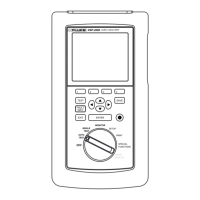
Do you have a question about the Fluke DSP-100 and is the answer not in the manual?
| Model | DSP-100 |
|---|---|
| Category | Cable Tester |
| Frequency Range | 1 MHz to 100 MHz |
| Display | LCD |
| Cable Types Tested | Coaxial |
| Supported Standards | ISO/IEC 11801 |
| Measurements | Length, Attenuation, NEXT |
| Interface | RS-232 |
| Weight | 1.5 kg |
| Operating Temperature | 0°C to 50°C |
| Storage Temperature | -20°C to 60°C |
| Test Capabilities | Wiremap, Length, Attenuation, NEXT, Return Loss |
Describes the features of the DSP-100 and DSP-2000 test tools for LAN cable analysis.
Lists the accessories included with the Fluke DSP-100/2000 LAN CableMeter.
Provides instructions on how to effectively use the manual for the test tool.
Details safety precautions and operational guidelines for using the test tool.
Covers quick start, powering, menus, and initial configuration for using the test tool.
Explains how to perform Autotests on twisted pair and coaxial cables.
Details main unit features, remote features, and rotary switch operations.
Covers setup options, language selection, and power management features.
Explains remote end testing, communication errors, and battery status indications.
Describes Autotest softkeys and how to interpret results for twisted pair cables.
Details Autotest procedures for twisted pair and coaxial cables.
Explains headrooms, diagnostics, and individual test results like Wire Map and Resistance.
Covers Propagation Delay, Skew, Characteristic Impedance, Attenuation, NEXT, ACR, and Return Loss.
Instructions on saving Autotest results and understanding the Autotest report format.
How to run individual tests and use features like scanning and remote units.
Explains the TDX analyzer and TDR tests, including how to run them and interpret results.
How to run individual tests on coaxial cables, including Impedance, Resistance, and Length.
Covers monitoring network activity, impulse noise, and determining hub port capabilities.
Instructions for using the tone generator (Model DSP-2000) for cable identification.
Instructions on sending saved test reports directly to a printer or PC.
How to configure serial port settings and connect to a printer.
Instructions for viewing, renaming, and deleting test reports from memory.
How to calibrate the test tool with remote units for accurate results.
How to determine NVP values and configure custom cable test standards.
Covers LAN cable construction, twisted pair, and coaxial cable types.
Explains Attenuation, Noise, Characteristic Impedance, and Crosstalk (NEXT).
Details TDR, its principles, and how to interpret reflections from cable faults.
General procedures and tables for finding and identifying cable faults.
Covers cleaning, battery replacement, and troubleshooting common test tool failures.
Lists specifications for cable types, test standards, impedance, length, delay, and more.
Details serial interface, PC interface cable, power, environmental requirements, and ratings.
Lists certifications, memory, dimensions, weight, display, connector, and warranty.
Instructions on installing and using the DSP-LINK software for PC communication.
Provides definitions of technical terms related to LAN cabling and testing.
Lists the tests performed for each supported Autotest standard.